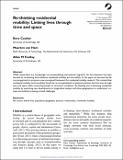Files in this item
Re-thinking residential mobility : linking lives through time and space
Item metadata
| dc.contributor.author | Coulter, Rory | |
| dc.contributor.author | Van Ham, Maarten | |
| dc.contributor.author | Findlay, Allan MacKay | |
| dc.date.accessioned | 2015-03-19T17:01:01Z | |
| dc.date.available | 2015-03-19T17:01:01Z | |
| dc.date.issued | 2016-06-01 | |
| dc.identifier | 175350248 | |
| dc.identifier | a7fb409c-3e8a-4494-aef7-be407c8bc70b | |
| dc.identifier | 84967222562 | |
| dc.identifier | 000376288900004 | |
| dc.identifier.citation | Coulter , R , Van Ham , M & Findlay , A M 2016 , ' Re-thinking residential mobility : linking lives through time and space ' , Progress in Human Geography , vol. 40 , no. 3 , pp. 352-374 . https://doi.org/10.1177/0309132515575417 | en |
| dc.identifier.issn | 0309-1325 | |
| dc.identifier.other | BibCode: NIS175350248 | |
| dc.identifier.other | ORCID: /0000-0002-2106-0702/work/64697569 | |
| dc.identifier.uri | https://hdl.handle.net/10023/6270 | |
| dc.description | Rory Coulter’s work on this paper was partly supported by an Economic and Social Research Council grant [ES/L009498/1]. Maarten van Ham’s contribution was supported by funding from the European Research Council under the European Union’s Seventh Framework Programme (FP/2007–2013) / ERC Grant Agreement n. 615159 (ERC Consolidator Grant DEPRIVEDHOODS, Socio-spatial inequality, deprived neighbourhoods, and neighbourhood effects); and from the Marie Curie programme under the European Union’s Seventh Framework Programme (FP/2007–2013) / Career Integration Grant no. PCIG10-GA-2011-303728 (CIG Grant NBHCHOICE, Neighbourhood choice, neighbourhood sorting, and neighbourhood effects). Allan Findlay’s work was supported by an Economic and Social Research Council grant [ES/K007394/1]. | en |
| dc.description.abstract | While researchers are increasingly re-conceptualizing international migration, far less attention has been devoted to re-thinking short-distance residential mobility and immobility. In this paper we harness the life course approach to propose a new conceptual framework for residential mobility research. We contend that residential mobility and immobility should be re-conceptualized as relational practices that link lives through time and space while connecting people to structural conditions. Re-thinking and re-assessing residential mobility by exploiting new developments in longitudinal analysis will allow geographers to understand, critique and address pressing societal challenges. | |
| dc.format.extent | 23 | |
| dc.format.extent | 313970 | |
| dc.language.iso | eng | |
| dc.relation.ispartof | Progress in Human Geography | en |
| dc.subject | Life course | en |
| dc.subject | Linked lives | en |
| dc.subject | Population geography | en |
| dc.subject | Practice | en |
| dc.subject | Relationality | en |
| dc.subject | Residential mobility | en |
| dc.subject | GF Human ecology. Anthropogeography | en |
| dc.subject | T-NDAS | en |
| dc.subject | BDC | en |
| dc.subject | R2C | en |
| dc.subject.lcc | GF | en |
| dc.title | Re-thinking residential mobility : linking lives through time and space | en |
| dc.type | Journal article | en |
| dc.contributor.sponsor | European Research Council | en |
| dc.contributor.sponsor | Economic & Social Research Council | en |
| dc.contributor.sponsor | Economic & Social Research Council | en |
| dc.contributor.institution | University of St Andrews. School of Geography & Sustainable Development | en |
| dc.contributor.institution | University of St Andrews. Geography & Sustainable Development | en |
| dc.identifier.doi | 10.1177/0309132515575417 | |
| dc.description.status | Peer reviewed | en |
| dc.identifier.grantnumber | ERC-2013-CoG | en |
| dc.identifier.grantnumber | ES/K007394/1 | en |
| dc.identifier.grantnumber | ES/K000446/1 | en |
This item appears in the following Collection(s)
Items in the St Andrews Research Repository are protected by copyright, with all rights reserved, unless otherwise indicated.

